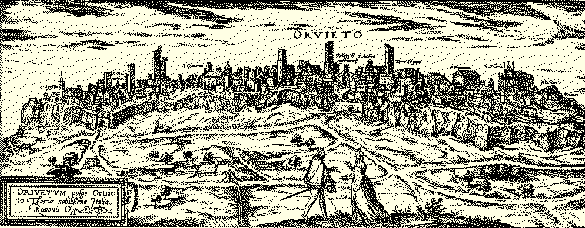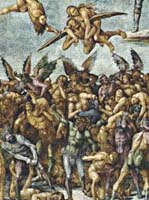
ORVIETO :
 An
enchanting city situated close to the border with Lazio, Orvieto rises up on a
crag of tufa emerging from the hills. The territory of Orvieto has been
populated since remote times, even if its first known inhabitants were the
Etruscans, who called it Volsinii. The Romans destroyed the town in the first
half of the III cent. BC. During the Middle Ages, when the town came to be known
as URBS VETUS, it enjoyed a period of prolific artistic and political
advancement. The Cathedral is a stunning example of the Gothic style.
An
enchanting city situated close to the border with Lazio, Orvieto rises up on a
crag of tufa emerging from the hills. The territory of Orvieto has been
populated since remote times, even if its first known inhabitants were the
Etruscans, who called it Volsinii. The Romans destroyed the town in the first
half of the III cent. BC. During the Middle Ages, when the town came to be known
as URBS VETUS, it enjoyed a period of prolific artistic and political
advancement. The Cathedral is a stunning example of the Gothic style.
 It was
constructed between 1290 and 1330. Its fašade, created by Lorenzo Maitani, is
rich of decorative sculptures and mosaics. The grandiose interior is
characterized, among other things, by the exquisite frescoes by Luca Signorelli
in the New Chapel - particularly the painting of the Last Judgement - and
by the reliquary "del Corporale", a silver casket by Ugolino di Vieri. Another
symbol of Orvieto is the Captain of the People's Palace. It's an imposing
turreted building
It was
constructed between 1290 and 1330. Its fašade, created by Lorenzo Maitani, is
rich of decorative sculptures and mosaics. The grandiose interior is
characterized, among other things, by the exquisite frescoes by Luca Signorelli
in the New Chapel - particularly the painting of the Last Judgement - and
by the reliquary "del Corporale", a silver casket by Ugolino di Vieri. Another
symbol of Orvieto is the Captain of the People's Palace. It's an imposing
turreted building
 (XII -XIII
cent.), decorated by mullioned windows and an external flight of steps. St
Patrick's Well is a masterly piece of Renaissance architecture. Antonio da
Sangallo the Younger projected it with two parallel concentric staircases (each
one having 248 steps) which never cross. The Necropolis of the Tufa Crucifix was
built at the bottom of the tufa crag. Interesting remains of chamber tombs and
burial apparel have been discovered on this site.
(XII -XIII
cent.), decorated by mullioned windows and an external flight of steps. St
Patrick's Well is a masterly piece of Renaissance architecture. Antonio da
Sangallo the Younger projected it with two parallel concentric staircases (each
one having 248 steps) which never cross. The Necropolis of the Tufa Crucifix was
built at the bottom of the tufa crag. Interesting remains of chamber tombs and
burial apparel have been discovered on this site.